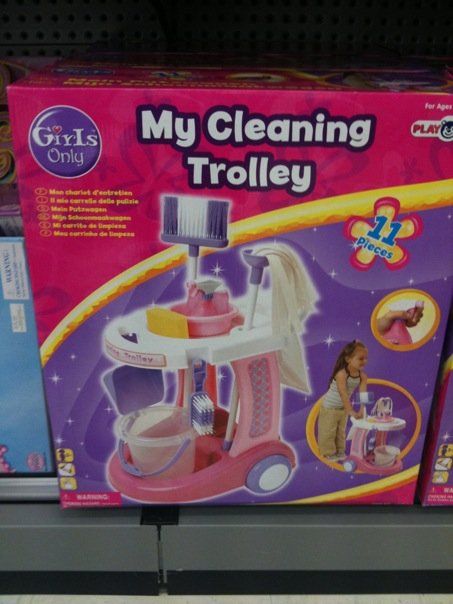Stereotypes of Gender Roles in the Media
Stereotypes in the media are used to generalize a group of people so that the audience can make an immediate opinion on the subject.
Many toy companies use stereotypes, to target young children into buying specific toys and products. One example would be the stereotype that women belong in the kitchen, therefore toy companies market kitchen sets and toy cookers to young girls giving the message that when they grow up they should be in the kitchen. Another stereotype sold as a children's toy would be baby dolls. Through the seemingly innocent product young girls are taught their most important duty in life is to take care of children, not to pursue a career or any sort of vocation but to procreate. On the other hand the stereotype for boys is that they should be strong, and masculine so toy companies insist that young boys should play with cars and trucks and want to grow up to be strong, manly, and dominant like action men figures.
  |
| Some highly stereotypical children's toys, notice the 'Girls Only' badge on the cleaning trolley.. |
In adverts for adults, women are more commonly presented as they are seen as the ones who buy all of the everyday goods. Furthermore they are shown either cooking, cleaning or taking care of children because that fits the stereotype of a perfect woman. Cosmetic companies use the stereotype that women need to be pretty and always well presented by showing images of women that society deems to be beautiful in an attempt to convince women that only with makeup can they be beautiful in society. This also highlights the idea that women are objects as they need to be good looking in order to be noticed by the opposite sex. However some companies have taken the campaign of using makeup to highlight your favourite features instead of conceal your flaws, this is a more positive way of selling makeup as the customer doesn't feel pressured to purchase it in order to fit in but instead sees the product that will give them the personal gain of self confidence.
Men however, are used to advertise cars, or business products, and are shown outdoors because being successful and bringing home an income for their household as that is what constitutes being 'manly'. There are sometimes women in male adverts for example the Lynx adverts where the women are so easily attracted to the man wearing the deodorant, it gives the impression that women are stupid and also objects that are there for men to attract and desire.
The music industry is not exempt from using gender stereotypes. It is very common for women to in music videos to be the subject to sexual objectification. As aforementioned, this is because of the stereotype that women are of a second class to men. A perfect example of this would be the infamous Blurred Lines music video by Robin Thicke and Pharrell Williams. In this video the three men walking around singing are completely clothed, however the women surrounding them are wearing very little clothes if any, and the clothes they are wearing are made out of clear plastic. Not only do the lyrics give countless amounts of objectification and even some rape culture, in some cases the men lead the women round by their ponytails, which shows the imagery of dogs not humans. To emphasise this inequality, a parody video was made whereby the roles were reversed and the men were half naked, however it was taken down by YouTube as it was reported 'inappropriate'.
Inequality is perhaps most evident in magazine covers. Below are two magazine covers, both for the same magazine, therefore have the same target audience. On the left the women is nearly topless, but on the right the man is completely fully clothed. This just emphasises the problem in society when women are required to show more skin an sexualise themselves in order to be at the same professional level as men. They are both professional golfers, and I assume they must be highly skilled as they on the front cover, yet they are both presented in completely different ways. The women is sexualised and the man is shown to be professional. Only on this platform of media is it so evident of the massive inequalities between the genders.
To conclude, in the media there is a HUGE difference between how each sex is represented. Women are most commonly used as sexual objects to sell, pretty much any product. Women are being made to sexualise themselves just to even attempt to make it to the same platform as men which isn't right. Nevertheless men are subject to some types of negative stereotypes, they just aren't as common as women's derogatory publicity. I think by stopping children being pressured into fitting certain gender stereotypes they should be encouraged to embrace their individual diversities so that when they grow up it can become a level playing field.
Sources:
/forum.bodybuilding.com/showthread.php?t=166807551








Darcy Grimes i like this a lot very simple yet covers the topic ver well. You use great examples, terminology your opinion and comparison to highlight your well made points, Keep it up.
ReplyDelete